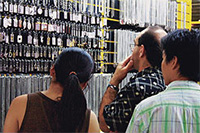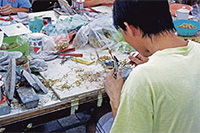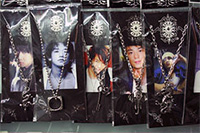Lead Toxins Take a Global Round Trip
'E-Waste' From Computers Discarded in West Turns Up In China's Exported Trinkets
by Gordon Fairclough, The Wall Street Journal (Page B1)
 |
 |
 |
 |
| |
 |
|
| |
Jewelry and key chains at the wholesale market in Yiwu, China. ©Junho Kim |
|
 |
 |
 |
| |
 |
|
| |
A worker at the Yiwu Zhongtai Ornament Co. ©Junho Kim |
|
 |
 |
 |
| |
 |
|
| |
Lead alloy scrap at the Yiwu Zhongtai Ornament Co. ©Junho Kim |
|
 |
 |
 |
| |
 |
|
| |
Costume-jewelry pendants displayed for sale at the Yiwu wholesale market. ©Junho Kim |
|
 |
 |
 |
|
| |
12 July 2007 (Yiwu, China) – High levels of toxic lead turning up in cheap jewelry from China are prompting recalls in the U.S. But some of the lead used by these Chinese manufacturers comes from an unconventional source: computers and other electronic goods discarded in Western countries and dumped in China.
Liu Mouye, owner of the Yiwu Yiming Alloy Factory here, says the lead alloy she sells to jewelry makers around Yiwu -- an important hub for low-priced Chinese exports -- is made in part from so-called e-waste that arrives by ship in southern China from the U.S. and other developed countries.
"I've seen the containers come in," Ms. Liu says. "Each one has about 60 tons of parts removed from machines and appliances" from abroad.
Two recent studies suggest lead from such sources is turning up in Chinese-made jewelry sold at U.S. discount stores and malls -- closing a globalization loop in which toxic materials from high-tech garbage are turned into potentially dangerous goods for kids and shipped back.
Jeffrey Weidenhamer and Michael Clement, chemists at Ashland University in Ohio, studied the composition of children's highly leaded jewelry and key chains found in stores last year and determined that some also contained levels of copper and tin that suggested the source was lead solder used in electronic circuit boards. Other jewelry samples were also found to contain antimony, a toxic metalloid element used to harden lead used in batteries.
The United Nations estimates that up to 50 million tons of e-waste is thrown away world-wide each year. Large amounts are shipped into China, even though the country's laws essentially ban imports of e-waste, according to China's State Environmental Protection Administration.
For lead, the trip to China from the U.S. typically goes something like this: U.S. consumers and businesses send their old electronics to recycling firms -- often by way of innocuous recycling drives. Some of those firms then sell the electronics to dealers in the U.S., who sell them to dealers in China. Chinese companies buy the e-waste and strip lead and other re-sellable materials from it -- often discarding harmful materials along the way, adding to local pollution. Those firms then sell the recovered lead to alloy makers like Ms. Liu, who provide it to Chinese manufacturers. The lead makes its way -- sometimes at toxic levels -- into trinkets sold to consumers in the U.S.
"This 'return-to-sender' issue is really important," says Ted Smith, founder of the Silicon Valley Toxics Coalition, an organization in San Jose, Calif., focused on the environmental impact of the high-tech industry. Mr. Smith points out an added irony: Many of the electronics consumed in the U.S. are manufactured in China in the first place. "Talk about globalization," he says. "If you drew a map of this, the arrows would go in lots of different directions."
The U.S. Environmental Protection Agency says it doesn't regulate the export of most old electronics, including cellphones and the circuit boards that make computers run, in either a "shredded" or intact form, because it considers them non-hazardous. In January, however, the agency began enforcing a new rule specific to cathode-ray tubes -- the TV and computer display screens that are commonly known as CRTs and contain lead. Now, exporters of intact or broken CRTs destined for recycling must notify the EPA of the export and get permission from the country importing the CRTs before doing so.
The EPA doesn't have any laws that ban the export of non-hazardous waste -- so if what it defines as non-hazardous waste is sent to another country, it doesn't know. "We have had some very general inquiries from the Chinese government saying they want to discuss this area, but we do not generally get requests from China regarding the shipped materials," says Bob Tonetti, an e-waste expert at the EPA.
Amid rising concerns about the safety of exports from China, lead has become a particular focus -- especially in items made for children. This year the U.S. Consumer Product Safety Commission has issued 18 recall notices affecting more than 6.7 million pieces of jewelry for children and teenagers that it says contain dangerous levels of lead -- almost all of it made in China. That's a sharp increase from 10 lead-related recalls in 2006 and three the year before that.
"In recent years, we've seen an influx of metal children's jewelry" that has "high levels of accessible lead," says agency spokesman Scott Wolfson.
Public-health officials have been fighting for years to keep lead out of children's jewelry. Lead has even turned up in snaps on Chinese-made overalls and shirts for babies and toddlers and on gardening gloves for kids. Ingested, it can cause brain damage and death. The risk is highest for young children, who are more likely to mouth or swallow pieces of jewelry. A new California law essentially limits the lead content of the base metal in children's jewelry to 0.06% starting Sept. 1. (New regulations for adult jewelry go into effect March 1.) The Consumer Product Safety Commission uses the 0.06% limit as a guideline on children's jewelry and has proposed it as a federal regulation.
The recalled jewelry ranged from "Best Friends Forever" necklaces sold at accessories retailer Claire's Stores Inc. to necklace and earring sets with plastic "birthstones" sold by Sears Holdings Corp.'s Kmart stores. The commission has also issued recalls this year for Chinese-made toys coated with lead paint.
Enforcement efforts have escalated since a child died last year in Minneapolis of acute lead poisoning after swallowing a Chinese-made charm from a bracelet given away with Reebok sneakers.
A spokeswoman for Claire's didn't return a call seeking comment.
Christian Brathwaite, a spokesman for Sears Holdings, says "Kmart takes customers' safety very seriously," adding: when a "product has been identified as having an issue with lead, we've stopped selling that product."
In China, however, lead alloy remains a favored material for costume-jewelry makers. It is plentiful and cheap, often selling for half the price of zinc alloy, the other metal mixture commonly used to make costume jewelry. Lead has a relatively low melting point, which makes it easier to work with, and lends heft to inexpensive jewelry.
The Chinese government sets limits on lead content in toys, but not in jewelry for children or adults. Many other countries also lack legal limits or fail to enforce them.
Companies like Ms. Liu's and other metal traders and alloy manufacturers say they buy lead from recyclers, mix it with other materials and sell it to jewelry makers in Yiwu and Qingdao in eastern Shandong province, two centers of costume-jewelry production in China. Nationwide, China's costume-jewelry industry has annual sales of about $4.5 billion -- and about 70% is exported.
In Yiwu, jewelry sellers make no secret of using toxic lead alloy in their products. They insist buyers know what they're getting and say using lead is the only way to offer the low prices that foreign purchasers are willing to pay.
Wang Xubin, the owner of Xu Lin Decoration Co., specializes in making costume jewelry for teenagers. His raw material of choice: a metal alloy that he says is 70% to 80% lead. The metal is molded into bracelets and pendants in the shape of crosses, eagles, dragons and crowns. "We do what our customers want. If they ask for no lead, we can do it," says Mr. Wang. "But a lot of Americans see the cost of lowering the lead content and say: 'forget it.'"
At Yiwu Zhongtai Ornament Co.'s factory on the outskirts of Yiwu, ingots of lead alloy are melted down in large crucibles. Young men then ladle the molten metal -- about 55% to 60% lead, according to the company -- by hand into rubber molds. On a recent visit, none of the workers was wearing protective facemasks or gloves.
Pieces of molded metal are then popped out, filed and plated with a thin coat of another metal, often a mixture of gold and silver or palladium. They are then assembled by rows of workers soldering and placing fake gemstones on the necklaces and earrings.
"It's too costly to make lead-free products," says owner Wang Qinjuan. "Chinese products have to be sold cheaply in foreign markets, or they are not competitive."
Some manufacturers say they are moving away from lead alloy at the request of customers, especially those from the U.S. and Western Europe. Nearly all say that, if a buyer wants them to, factories can lower the lead content of their products. "People can choose. We give them whatever they want," says Ni Lanzhen, a wholesaler of jewelry and trinkets, including a tiny ring topped with a lead flower. "But most of the market is lead alloy."
Some importers, on the other hand, complain insuring product quality from China can be difficult. Myles Marks, an employee of DM Merchandising in Elmhurst, Ill., says that his company stepped up testing after authorities discovered that some Chinese-made bracelets contained lead, which the company was unaware of. "There are items we've had to test and retest three and four times," says Mr. Marks, when they fail to meet lead standards. "It's a colossal pain. And it's certainly costly."
Mr. Marks says that sometimes Chinese suppliers will "do the old bait and switch," winning an order with a product that meets an importer's specifications and then mass producing the items with cheaper, lead-containing, materials. But while many companies express frustration, few, including DM Merchandising, are willing to publicly identify their Chinese suppliers.
Meanwhile, the e-waste problem is attracting the attention of some lawmakers. Congressman Tom Lantos, chairman of the House Foreign Affairs Committee, recently sent a letter to the U.S. Government Accountability Office expressing concern about the practice of exporting e-waste from the U.S. to foreign countries. Prompted by the letter, the GAO plans to begin research on the topic soon.
"We need this study to get an idea of the problem's global scope," Mr. Lantos said in an email. "I am concerned that U.S. consumers who recycle computers and other electronic equipment may be led to believe that they are doing good when in fact they are doing harm."
Vauhini Vara in San Francisco and Ellen Zhu in Shanghai contributed to this article
Write to Gordon Fairclough at gordon.fairclough@wsj.com
FAIR USE NOTICE. This document contains copyrighted material whose use has not been specifically authorized by the copyright owner. The Basel Action Network is making this article available in our efforts to advance understanding of ecological sustainability and environmental justice issues. We believe that this constitutes a 'fair use' of the copyrighted material as provided for in section 107 of the US Copyright Law. If you wish to use this copyrighted material for purposes of your own that go beyond 'fair use', you must obtain permission from the copyright owner.
More News
|